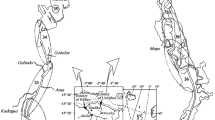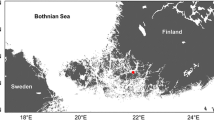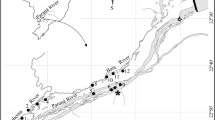Abstract
Gelatinous zooplankton (GZ) populations are sensitive to environmental perturbations, and regional changes in their abundance may be associated with degraded environmental conditions. Two time series of GZ abundances were used to analyze the population dynamics of gelatinous zooplankton in the Chesapeake Bay, USA from 1984 to 2012. Annual and interannual variations in population size and distribution of the scyphozoan medusae Chrysaora chesapeakei, Aurelia aurita, Cyanea capillata, and Rhopilema virrilli, as well as the lobate ctenophore Mnemiopsis leidyi, were compared with environmental conditions and other biological data. Scyphozoan population control by environmental factors was primarily a result of mortality and asexual reproduction by the benthic scyphistomae. C. chesapeakei was present year-round, but biovolume was highest in July–September and in salinities 9–20. M. leidyi populations were primarily controlled by C. chesapeakei predation and were most abundant in June, after waters warmed above 18 °C but before C. chesapeakei bloomed. Low bottom-water salinity was negatively correlated with summer C. chesapeakei biovolume, and low bottom dissolved oxygen concentrations delayed the timing of the peak bloom. Total GZ biovolume decreased in both time series (1984–2012), likely due to decreases in C. chesapeakei abundance. This reduction in C. chesapeakei allowed for a concurrent increase in M. leidyi and decrease in copepod abundance. Predicted future increases in spring streamflow and spring hypoxia due to global climate change would further decrease C. chesapeakei abundance, possibly allowing for future increase in M. leidyi populations.









Similar content being viewed by others
References
Albert, David J. 2010. Vertical distribution of Aurelia labiata (Scyphozoa) jellyfish in Roscoe Bay is similar during flood and ebb tides. Journal of Sea Research 64 (3): 422–425.
Albert, David J. 2011. What’s on the mind of a jellyfish? A review of behavioural observations on Aurelia sp. jellyfish. Neuroscience and Biobehavioral Reviews 35 (3): 474–482.
Bayha, Keith M., Allen G. Collins, and Patrick M. Gaffney. 2017. Multigene phylogeny of the scyphozoan jellyfish family Pelagiidae reveals that the common U.S. Atlantic Sea nettle comprises two distinct species (Chrysaora quinquecirrha and C. chesapeakei). PeerJ 5: e3863. https://doi.org/10.7717/peerj.3863.
Breitburg, Denise L., and Rebecca Burrell. 2014. Predator-mediated landscape structure: Seasonal patterns of spatial expansion and prey control by Chrysaora quinquecirrha and Mnemiopsis leidyi. Marine Ecology Progress Series 510: 183–200.
Breitburg, Denise L., and Richard S. Fulford. 2006. Oyster-sea nettle interdependence and altered control within the Chesapeake Bay ecosystem. Estuaries and Coasts 29 (5): 776–784.
Breitburg, Denise L., Aaron Adamack, Kenneth A. Rose, Sarah E. Kolesar, Mary Beth Decker, Jennifer E. Purcell, Julie E. Keister, and James H. Cowan Jr. 2003. The pattern and influence of low dissolved oxygen in the Patuxent River, a seasonally hypoxic estuary. Estuaries 26 (2A): 280–297.
Brotz, Lucas, William W.L. Cheung, Kristin Kleisner, Evgeny Pakhomov, and Daniel Pauly. 2012. Increasing jellyfish populations: Trends in large marine ecosystems. Hydrobiologia 690 (1): 3–20.
Brown, Christopher W., Raleigh R. Hood, Zhen Li, Mary Beth Decker, Thomas F. Gross, Jennifer E. Purcell, and Harry V. Wang. 2002. Forecasting system predicts presence of sea nettles in Chesapeake Bay. Eos, Transactions American Geophysical Union 83 (30): 321.
Cargo, David G., and David R. King. 1990. Forecasting the abundance of the sea nettle, Chrysaora quinquecirrha, in the Chesapeake Bay. Estuaries 13 (4): 486–491.
Cargo, David G., and Leonard P. Schultz. 1966. Notes on the biology of the sea nettle, Chrysaora quinquecirrha, in Chesapeake Bay. Chesapeake Science 7 (2): 95–100.
Cargo, David G., and Leonard P. Schultz. 1967. Further observations on the biology of the sea nettle and jellyfishes in Chesapeake Bay. Chesapeake Science 8 (4): 209–220.
Ceh, Janja, Jorge Gonzalez, Aldo S. Pacheco, and José M. Riascos. 2015. The elusive life cycle of scyphozoan jellyfish – Metagenesis revisited. Scientific Reports 5 (1): 12037.
Cochran, William G. 1977. Sampling techniques. New York: Wiley.
Condon, Robert H., and Deborah K. Steinberg. 2008. Development, biological regulation, and fate of ctenophore blooms in the York River estuary, Chesapeake Bay. Marine Ecology Progress Series 369: 153–168.
Condon, Robert H., and Deborah K. Steinberg. 2009. Zooplankton of the York River. Journal of Coastal Research 57: 66–79.
Condon, Robert H., Mary Beth Decker, and Jennifer E. Purcell. 2001. Effects of low dissolved oxygen on survival and asexual reproduction of scyphozoan polyps (Chrysaora quinquecirrha). Hydrobiologia 451 (1/3): 89–95.
Condon, Robert H., Carlos M. Duarte, Kylie A. Pitt, Kelly L. Robinson, Cathy H. Lucas, Kelly R. Sutherland, Hermes W. Mianzan, Molly Bogeberg, Jennifer E. Purcell, Mary Beth Decker, Shin-ichi Uye, Laurence P. Madin, Richard D. Brodeur, Steven H.D. Haddock, Alenka Malej, Gregory D. parry, Elena Eriksen, Javier Quiñones, Marcelo Acha, Michel Harvey, James M. Arthus, and William M. Graham. 2013. Recurrent jellyfish blooms are a consequence of global oscillations. PNAS 110 (3): 1000–1005.
Cones, Harold N., and Dexter S. Haven. 1969. Distribution of Chrysaora quinquecirrha in the York river. Chesapeake Science 10 (2): 75–84.
Costello, J.H., B.K. Sullivan, D.J. Gifford, D. Van Keuren, and L.J. Sullivan. 2006. Seasonal refugia, shoreward thermal amplification, and metapopulation dynamics of the ctenophore Mnemiopsis leidyi in Narragansett Bay, Rhode Island. Limnology and Oceanography 51 (4): 1819–1831.
Costello, J.H., K.M. Bayha, H.W. Mianzan, T.A. Shiganova, and J.E. Purcell. 2012. Transitions of Mnemiopsis leidyi (Ctenophora: Lobata) from a native to an exotic species: A review. Hydrobiologia 690 (1): 21–46.
Cowan, James H., Jr., and Edward D. Houde. 1993. Relative predation potentials of scyphomedusae, ctenophores and planktivorous fish on ichthyoplankton in Chesapeake Bay. Marine Ecology Progress Series 95: 55–65.
Crum, Kevin P., Heidi L. Fuchs, Paul A.X. Bologna, and John J. Gaynor. 2014. Model-to-data comparisons reveal influence of jellyfish interactions on plankton community dynamics. Marine Ecology Progress Series 517: 105–119.
Decker, Mary Beth, Denise L. Breitburg, and Jennifer E. Purcell. 2004. Effects of low dissolved oxygen on zooplankton predation by the ctenophore Mnemiopsis leidyi. Marine Ecology Progress Series 280: 163–172.
Decker, M.B., C.W. Brown, R.R. Hood, J.E. Purcell, T.F. Gross, J.C. Matanoski, R.O. Bannon, and E.M. Setzler-Hamilton. 2007. Predicting the distribution of the scyphomedusa Chrysaora quinquecirrha in Chesapeake Bay. Marine Ecology Progress Series 329: 99–113.
Diaz, Robert J., and Rutger Rosenberg. 1995. Marine benthic hypoxia: A review of its ecological effects and the behavioral responses of benthic macrofauna. Oceanography and Marine Biology, An Annual Review 33: 245–303.
Diaz, Robert J., and Rutger Rosenberg. 2008. Spreading dead zones and consequences for marine ecosystems. Science 321 (5891): 926–929.
Diaz, Robert J., R.J. Neubauer, L.C. Schaffner, L. Pihl, and S.P. Baden. 1992. Continuous monitoring of dissolved oxygen in an estuary experiencing periodic hypoxia and the effect of hypoxia on macrobenthos and fish. Science of the Total Environment, Supplement 1992: 1055–1068.
Elliott, David T., James J. Pierson, and Michael R. Roman. 2013. Predicting the effects of coastal hypoxia on vital rates of the planktonic copepod Acartia tonsa. PLoS One 8 (5): e63987.
Gatz, A. John, Jr., Victor S. Kennedy, and Joseph A. Mihursky. 1973. Effects of temperature on activity and mortality of the scyphozoan medusa, Chrysaora quinquecirrha. Chesapeake Science 14 (3): 171–180.
Govoni, John J., and John E. Olney. 1991. Potential predation on fish eggs by the lobate ctenophore Mnemiopsis leidyi within and outside the Chesapeake Bay plume. Fishery Bulletin 89: 181–186.
Grove, Michael, and Denise L. Breitburg. 2005. Growth and reproduction of gelatinous zooplankton exposed to low dissolved oxygen. Marine Ecology Progress Series 301: 185–198.
Hagy, James D., Walter R. Boynton, Carolyn W. Keefe, and Kathryn V. Wood. 2004. Hypoxia in Chesapeake Bay, 1950–2001: Long-term change in relation to nutrient loading and river flow. Estuaries 27 (4): 634–658.
Han, Chang-hoon, and Shin-ichi Uye. 2010. Combined effects of food supply and temperature on asexual reproduction and somatic growth of polyps of the common jellyfish Aurelia aurita s.l. Plankton and Benthos Research 5 (3): 98–105.
Harper, Donald E., and Randy J. Runnels. 1990. The occurrence of Rhopilema verrilli (Cnidaria: Scyphozoa: Rhizostomeae) on Galveston Island, Texas and a discussion on its distribution in U.S. waters. Northeast Gulf Science 11 (1): 19–27.
Holst, Sabine, and Gerhard Jarms. 2010. Effects of low salinity on settlement and strobilation of Scyphozoa (Cnidaria): Is the lion’s mane Cyanea capillata (L.) able to reproduce in the brackish Baltic Sea? Hydrobiologia 645 (1): 53–68.
Houde, E.D., J.C. Gamble, S.E. Dorsey, and J.H. Cowan Jr. 1994. Drifting mesocosms: The influence of gelatinous zooplankton on mortality of bay anchovy, Anchoa mitchilli, eggs and yolk-sac larvae. ICES Journal of Marine Science 51 (4): 383–394.
Jaspers, Cornelia, Lene Friis Møller, and Thomas Kiørboe. 2011. Salinity gradient of the Baltic Sea limits the reproduction and population expansion of the newly invaded comb jelly Mnemiopsis leidyi. PLoS One 6 (8): e24065.
Johnson, William S., Dennis M. Allen, M. Virginia Ogburn, and Stephen E. Stancyk. 1990. Short-term predation responses of adult bay anchovies Anchoa mitchilli to estuarine zooplankton availability. Oldendorf 64: 55–68.
Kimmel, David G., and Michael R. Roman. 2004. Long-term trends in mesozooplankton abundance in Chesapeake Bay, USA: Influence of freshwater input. Marine Ecology Progress Series 267: 71–83.
Kimmel, David G., Walter R. Boynton, and Michael R. Roman. 2012. Long-term decline in the calanoid copepod Acartia tonsa in Central Chesapeake Bay, USA: An indirect effect of eutrophication? Estuarine, Coastal and Shelf Science 101: 76–85.
Kolesar, Sarah E., Denise L. Breitburg, Jennifer E. Purcell, and Mary Beth Decker. 2010. Effects of hypoxia on Mnemiopsis leidyi, ichthyoplankton and copepods: Clearance rates and vertical habitat overlap. Marine Ecology Progress Series 411: 173–788.
Kremer, Patricia. 1976. Population dynamics and ecological energetics of a pulsed zooplankton predator, the ctenophore Mnemiopsis leidyi. In Estuarine Processes, ed. M.L. Wiley, vol. 1, 197–215. New York: Academic Press.
Kremer, Patricia. 1994. Patterns of abundance for Mnemiopsis in US coastal waters: A comparative overview. ICES Journal of Marine Science 51 (4): 347–354.
Liu, Wen-Cheng, Wen-Tseng Lo, Jennifer E. Purcell, and Hao-Hsien Chang. 2009. Effects of temperature and light intensity on asexual reproduction of the scyphozoan, Aurelia aurita (L.) in Taiwan. Hydrobiologia 616 (1): 247–258.
Mills, Claudia E. 2001. Jellyfish blooms: Are populations increasing globally in response to changing ocean conditions? Hydrobiologia 451 (1/3): 55–68.
Murphy, Rebecca R., W. Michael Kemp, and William P. Ball. 2011. Long-term trends in Chesapeake Bay seasonal hypoxia, stratification, and nutrient loading. Estuaries and Coasts 34 (6): 1293–1309.
Najjar, Raymond G., Christopher R. Pyke, Mary Beth Adams, Denise Breitburg, Carl Hershner, Michael Kemp, Robert Howarth, Margaret R. Mulholland, Michael Paolisso, David Secor, Kevin Sellner, Denice Wardrop, and Robert Wood. 2010. Potential climate-change impacts on the Chesapeake Bay. Estuarine, Coastal and Shelf Science 86 (1): 1–20.
Oguz, Temel, Bettina Fach, and Baris Salihoglu. 2008. Invasion dynamics of the alien ctenophore Mnemiopsis leidyi and its impact on anchovy collapse in the Black Sea. Journal of Plankton Research 30 (12): 1385–1397.
Pörtner, H.O. 2001. Climate change and temperature-dependent biogeography: Oxygen limitation of thermal tolerance in animals. Naturwissenschaften 88: 137–146.
Purcell, Jennifer E. 1992. Effects of predation by the scyphomedusan Chrysaora quinquecirrha on zooplankton populations in Chesapeake Bay. Marine Ecology Progress Series 87: 65–76.
Purcell, Jennifer E. 2005. Climate effects on formation of jellyfish and ctenophore blooms. Journal of the Marine Biological Association of the U.K. 85 (3): 461–476.
Purcell, Jennifer E., and James H. Cowan Jr. 1995. Predation by the scyphomedusan Chrysaora quinquecirrha on Mnemiopsis leidyi ctenophores. Marine Ecology Progress Series 128: 63–70.
Purcell, Jennifer E., and Mary Beth Decker. 2005. Effects of climate on relative predation by scyphomedusae and ctenophores on copepods in Chesapeake Bay during 1987-2000. Limnology and Oceanography 50 (1): 376–387.
Purcell, Jennifer E., Frances P. Cresswell, David G. Cargo, and Victor S. Kennedy. 1991. Differential ingestion and digestion of bivalve larvae by the scyphozoan Chrysaora quinquecirrha and the ctenophore Mnemiopsis leidyi. Biological Bulletin 180 (1): 103–111.
Purcell, Jennifer E., Jacques R. White, and Miachael R. Roman. 1994. Predation by gelatinous zooplankton and resource limitation as potential controls of Acartia tonsa copepod populations in Chesapeake Bay. Limnology and Oceanography 39 (2): 263–278.
Purcell, Jennifer E., Jacques R. White, David A. Nemazie, and David A. Wright. 1999. Temperature, salinity and food effects on asexual reproduction and abundance of the scyphozoan Chrysaora quinquecirrha. Marine Ecology Progress Series 180: 187–196.
Purcell, Jennifer E., Tamara A. Shiganova, Mary Beth Decker, and Edward D. Houde. 2001. The ctenophore Mnemiopsis in native and exotic habitats: U.S. estuaries versus the Black Sea basin. Hydrobiologia 451 (1/3): 145–176.
Purcell, Jennifer E., Shin-ichi Uye, and Wen-Tseng Lo. 2007. Anthropogenic causes of jellyfish blooms and their direct consequences for humans: A review. Marine Ecology Progress Series 350: 153–174.
Purcell, Jennifer E., Dacha Atienza, Verónica Fuentes, Alejandro Olariaga, Uxue Tilves, Chandler Colahan, and Josep-María Gili. 2012. Temperature effects on asexual reproduction rates of scyphozoan species from the Northwest Mediterranean Sea. Hydrobiologia 690 (1): 169–180.
Reeve, Michael R., Mary Ann Syms, and Patricia Kremer. 1989. Growth dynamics of a ctenophore (Mnemiopsis) in relation to variable food supply. I. Carbon biomass, feeding, egg production, growth and assimilation efficiency. Journal of Plankton Research 11 (3): 535–552.
Rice, Karen C., and John D. Jastram. 2015. Rising air and stream-water temperatures in Chesapeake Bay region, USA. Climatic Change 128 (1-2): 127–138.
Roohi, Aboulghasem, Ahmet E. Kideys, Ameneh Sajjadi, Abdolla Hashemian, Reza Pourgholam, Hasan Fazli, Ali Ganjian Khanari, and Elif Eker-Develi. 2010. Changes in biodiversity of phytoplankton, zooplankton, fishes and macrobenthos in the Southern Caspian Sea after the invasion of the ctenophore Mnemiopsis leidyi. Biological Invasions 12 (7): 2343–2361.
Sexton, Margaret A., Raleigh R. Hood, Judith Sarkodee-adoo, and Amanda M. Liss. 2010. Response of Chrysaora quinquecirrha medusae to low temperature. Hydrobiologia 645 (1): 125–133.
Sokolowski, Adam, Dominika Brulinska, Michal Olenycz, and Maciej Wolowicz. 2016. Does temperature and salinity limit asexual reproduction of Aurelia aurita polyps (Cnidaria: Scyphozoa) in the Gulf of Gdansk (southern Baltic Sea)? An experimental study. Hydrobiologia 773 (1): 49–62.
Southworth, Melissa, Roger Mann. 2016. The status of Virginia’s public oyster resource, 2015. Molluscan Ecology Program, Virginia Institute of Marine Science, Gloucester Point, Virginia. 50 pp.
Steinberg, Deborah K., Michael W. Lomas, and Joseph S. Cope. 2012. Long-term increase in mesozooplankton biomass in the Sargasso Sea: Linkage to climate and implications for food web dynamics and biogeochemical cycling. Global Biogeochemical Cycles 26: GB1004.
Stone, Joshua P., and Deborah K. Steinberg. 2018. Influence of top-down control in the plankton food web on vertical carbon flux: A case study in the Chesapeake Bay. Journal of Experimental Marine Biology and Ecology 498: 16–24.
Tarnowski, Mitchell. 2015. Maryland oyster population status report: 2014 fall survey. Maryland Department of Natural Resources Publ. No. 17-782015-769, Annapolis, 68 pp.
Thuesen, Erik V., Ladd D. Rutherford Jr., Patricia L. Brommer, Kurt Garrison, Magdalena A. Gutowska, and Trisha Towanda. 2005. Intragel oxygen promotes hypoxia tolerance of scyphomedusae. Journal of Experimental Biology 208 (13): 2475–2482.
Tuckey, Troy D., and Mary C. Fabrizio. 2013. Influence of survey design on fish assemblages: Implications from a study in Chesapeake Bay tributaries. Transactions of the American Fisheries Society 142 (4): 957–973.
van der Veer, H.W., and W. Oorthuysen. 1985. Abundance, growth and food demand of the scyphomedusa Aurelia aurita in the western Wadden Sea. Netherlands Journal of Sea Research 19: 28–44.
Wang, Nan, Chaelun Li, Yi Liang, Yongqiang Shi, and Lu. Jingliang. 2015. Prey concentration and temperature effect on budding and strobilation of Aurelia sp. 1 polyps. Hydrobiologia 754 (1): 125–134.
Wright, David A., and Jennifer E. Purcell. 1997. Effect of salinity on ionic shifts in mesohaline scyphomedusae, Chrysaora quinquecirrha. Biological Bulletin 192 (2): 332–339.
Acknowledgments
We are grateful to the numerous technicians and crew of the Virginia Institute of Marine Science Juvenile Fish Trawl Survey and the Chesapeake Bay Program Mesozooplankton Survey for the many years of tireless sampling. Special thanks to Troy Tuckey, Wendy Lowery, Ben Marcek, and Cassidy Peterson for assistance with analysis of the VIMS Juvenile Fish Trawl Survey data.
Funding
This research was funded by Virginia Sea Grant (V718500) to D.K.S. and J.P.S. and grants from the Virginia Marine Resources Commission and National Oceanic and Atmospheric Administration—Chesapeake Bay Office to M.C.F. This is contribution number 3780 of the Virginia Institute of Marine Science, College of William & Mary.
Author information
Authors and Affiliations
Corresponding author
Additional information
Communicated by Wim J. Kimmerer
Electronic Supplementary Material
ESM 1
Supp. Fig. 1 Distribution of GZ biovolume and presence across salinity and temperature gradients in the VIMS dataset (2000–2012, in lower Chesapeake Bay). a Percent presence of Aurelia aurita, b percent presence of Cyanea capillata, and c percent presence of Rhopilema verrilli. “Percent presence” is the percentage of all tows that had a particular taxon present. Stars represent the mean center of distribution weighted by biovolume index or percent presence. (PNG 226 kb)
Rights and permissions
About this article
Cite this article
Stone, J.P., Steinberg, D.K. & Fabrizio, M.C. Long-Term Changes in Gelatinous Zooplankton in Chesapeake Bay, USA: Environmental Controls and Interspecific Interactions. Estuaries and Coasts 42, 513–527 (2019). https://doi.org/10.1007/s12237-018-0459-7
Received:
Revised:
Accepted:
Published:
Issue Date:
DOI: https://doi.org/10.1007/s12237-018-0459-7




